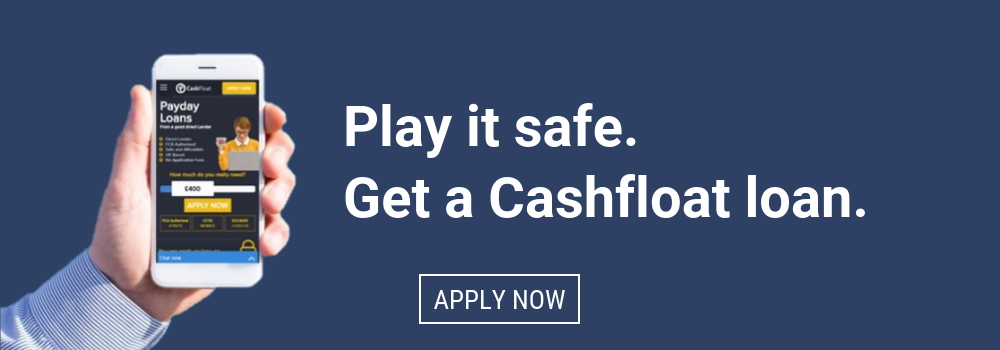Do you know the true cost of borrowing money? Cashfloat discovers the true cost and what to look out for when borrowing a loan.

The True Cost of Borrowing Money
As a responsible payday loan company, Cashfloat knows only too well that borrowing money is expensive and it should only be used if you understand the consequences and can afford the repayments. This article will help you understand the true cost of borrowing money so you can make an informed choice for when you want to borrow money such as a cheap pay day loan.
The true cost of borrowing money is the amount you are charged on top of the capital amount of the loan; such as the interest rate and additional fees. This will differ depending on your type of credit: Credit card, bank, a short term loan, family or friends.
- How you can calculate loan payments,
- Side costs
- The APR (Annual Percentage Rate)
This will help you see the whole picture before you decide to borrow. It also help you compare figures with the quotes given to you by your target set of banks or brokerage firms.
Different Aspects to Consider When Borrowing Money
When taking out a mortgage, alternatives to wage day loans, or anything in between, it is important to look carefully at different aspects of the loan in order to be aware of the true cost of borrowing money. Here we present several different aspects to consider when taking out a loan.
How much will you pay periodically?
Having to pay off debt monthly or quarterly, or whatever other option is available, is one of the main attractions to borrowing money. It allows you to shell out only a specific amount regularly. However, think carefully about whether your income will be able to cover this monthly expense.

What are the particulars you have to know?
In an interest-only payment, you have to know:
- The amount of the loan
Majority of the time it is up to you, but your lender will sometimes make adjustments depending on your affordability. - Rate of interest
The interest rate is the cost of borrowing the money. This is, in a sense, the price tag your lender places on its act of lending you cash. Gather information on the annual interest rate charged by each of the banks or lending institutions you are eyeing. You will read more about this later in the article. - Timeline of repayment
You also have to consider the length of time the loan is for.Is it every month, every quarter, every two months, bi-annually?
Once you have these three figures, you can start the calculation. Multiply the loan amount by the annual interest rate. Then divide the product by the times you have to pay in a year to discover the true cost of repayments.
For Example
Loan amount = £2500
Interest rate = 2.15%
Period = 12 months
The calculation will be:
£2500 x 2.15% = £5375 (amount to be paid in a year)
£5375 divided by 12 = £448 (rounded-up amount to be paid every month)
As the computation shows, your monthly payment for a loan amounting to £2500 , with a 2.15% annual rate, will be £448.
Do the Maths Yourself
By doing the math yourself, you gain a better understanding of what is at stake when you finally decide to take out a loan. You will also have done your research once started asking for quotes from potential lenders. It’s like going to the supermarket with a grocery checklist. Nobody will penalize you for not having it, but you will be confident arriving armed with the list of your needs to curb impulse buying. In the case of borrowing money, do not be surprised when you are given varying costs by bankers and brokers, just make a note of the varying percentage rates on paper for reference.
Aside from the manual computing option, there are also online calculators to aid you understand the true cost. Just plug in the information needed and the application will perform the trick for you.

What are the other fees that may be included in the true cost?
Aside from the interest rate, there will be other fees that will arise as you make periodic payments. You should also be looking at these factors before concluding that the deal you are getting is the best of your choices.
What are the additional costs you need to add to the capital cost of credit?
There are many other additional costs for borrowing money, including:
- Late payment dues
- In some case, prepayment dues and origination charge
- Default charge
- Settlement charge
- Loan application
- Underwriting services
- Payments processing
- Prepayment fee – a penalty for paying off a loan before its due date.
Remember: Interest rate is the equivalent amount in monetary form that they will earn from lending you the money. That is also the reason for high interest rates.
Take these factors into consideration so that you can have a clearer picture at the end of every yearly payment cycle. You can also input the additional costs into online calculators if you are not keen on computing manually.

What is APR?
APR stands for Annual Percentage Rate. It includes the total amount you will have to come up with over the course of your payment term and the additional fees. From the example above, you have to account for the monthly payment and the additional charges you may incur. Watch out for lower APRs, as this means lower cost borrowing.
The APR is not as easy to compute as it seems. To help you with the calculation, internet-based APR calculators exist.
Banks are required to tell you their APR. In the United Kingdom, APR computation is regulated by the Financial Conduct Authority, or the FCA. As there are two types of APR, personal and typical, you should concern yourself only with the typical APR. This is the advertised APR that a minimum 51% of customers need to pay. Try to know the APR so as to be ready to compare.
If you are looking to borrow a small loan with low APR, Cashfloat is the right place. With our new easy start option the APR on all our loans is significantly reduced.
Summary
Knowing this will paint the whole picture for you. Seeing how the figures differ according to the variables you plug into the equation, will help you compare apples to apples. In the end, you will know which lender is offering the best deal for you. And the best deal, after all, is the one that will cater to your needs and fit into your near-future or long-haul expenses, depending on the period you choose for repayment.


